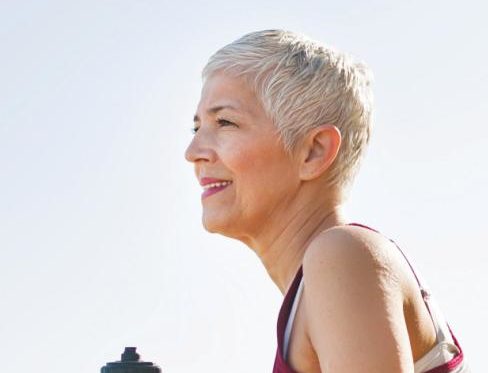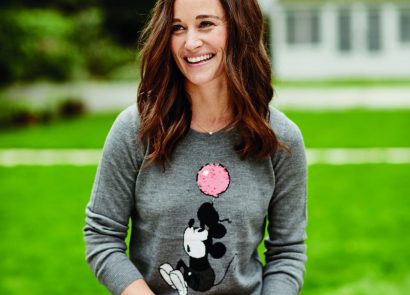Cardio
If you want to change your age at a cellular level, cardio is king. According to a study in the European Heart Journal, endurance exercises such as running, swimming and cycling are the best at slowing down the signs of ageing. In another study, people who took part in regular high intensity interval training (HIIT) improved their insulin levels, heart and lung health, and saw a reversal in age-related decline in mitochondrial function – that’s cell metabolism to you and I! “Anti-ageing is about more than heaping on the creams, it’s about actively trying to lower your biological age,” says Keith McNiven, founder of London based personal training company Right Path Fitness (rightpathfitness.com). “It’s a combination of both your genes and how well you’ve looked after your body – and a huge indicator is heart health. If your biological age exceeds your actual age, you can have prematurely hardening arteries and thickening walls. Look after your heart by doing anything that gets your heart rate up. With regular cardio three to four times a week, you’ll lower your maximum heart rate and keep it as young as it can be.”
Walking
If there were a prescription for anti-ageing, walking would be it. Numerous studies have suggested a daily walking routine can boot out age-related health problems including bone mass loss and hip fractures. “Walking is one of the best exercises you can possibly do,” affirms health activist and author of healthy lifestyle book Primal Cure (primalcure.com), Steve Bennett. “It can reduce heart disease, stroke, and manage high blood pressure, cholesterol, muscular pain and diabetes. It’s also extremely kind to our joints and almost anybody can do it. Getting outdoors also reaps endless anti-ageing rewards, boosting our vitamin D reserves, lifting our mood and reducing stress.” Fitness expert Laura Williams (Laurawilliamsonline.co.uk) suggests doing intervals for maximum effect. “Walk at a slow pace for three minutes, then spend 20 minutes doing 10 repeats of the following: power-walk at a fast pace for 1.5 minutes and walk at a moderate pace for 30 seconds. Then, spend 10 minutes alternating between two minutes of fast paced walking, with 30 seconds at a slower speed, twice, before cooling down at an easy walking pace for two to three minutes.”
Cycling
“New research shows that just 45 minutes of indoor cycling can boost the production of an anti-ageing compound called NRF1, which helps to protect DNA and keep cells younger,” says David Wiener, training and nutrition specialist at fitness app Freeletics (freeletics.com). “Cycling also helps with muscle fitness, circulation of blood around the body, which can boost skin cells and weight loss. Research by the British Heart Foundation shows that cycling at least 20 miles per week also reduces the risk of coronary heart disease.”
Yoga
Turning back the clock is also about stress reduction and flexibility, stretching muscles so the joints and tissues are stronger. “To breathe deep is to slow down our nervous system and racing mind, which helps with stress, fatigue, anxiety and burnout – all ageing effects of modern life,” says Deanne Oliver-Pickard, yoga trainer at Fly LDN (flyldn.co.uk). “Yoga is different to other cardiovascular exercises, as it lengthens the muscles, rather than tightens them – gaining ultimate strength but in a kinder way for the body. You open up the connective tissues and the muscles remain lean and youthful. It also helps circulation, improving the elasticity of the skin so it appears firmer and tighter, and targeting cellulite and wobbly arms.”
Squats
“Scientists have discovered a link between the strength of a person’s legs and the ability of their brain to resist the effects of ageing,” says David. “Squats are one of the best exercises to strengthen legs and promote mobility and balance. Pay attention to your form when squatting: squat down to varied depths while using your core and body strength to maintain balance before returning to a standing position. Add extra weights (such as dumbbells or cans of food) to increase the intensity.”
Weight training
You might be able to ‘train’ your tissues to behave the way they did when you were younger, too. A study by the Buck Centre for Age Research in the U.S tested older adults after six months of resistance training and found the exercises reversed many of the ageing processes at a genetic level. Strength-wise, before the training, the older adults were 59 percent weaker than the younger adults. After the six months of exercises, they improved by 50 percent. “Think of muscle as your body’s natural fat burner. As you age, your production of muscle slows, and is even lost, making you weaker and more susceptible to disease and illness. But regular training with weights can halt this, build new muscle and help you stay younger for longer,” affirms Keith. “Start with a warm-up, then begin with bentover rows for your back, keeping your knees soft and bringing the barbell up from your knees to your upper thighs. Move on to a shoulder press by taking the barbell from your chest right up until your arms are fully extended. Next, try lunges – keep the barbell across the back of your shoulders and lunging forward one leg at a time. Finish with some good mornings for the lower back, glutes and hamstrings – again, rest a barbell across the back of your shoulders and lean forwards as if you are doing a bowing motion, then rise and repeat. Do eight reps of each exercise and do the circuit three to four times.”
Brain training
OK, so you might not break a sweat but there’s a lot of evidence to suggest, if you work out your brain like your body, you’ll feel and think a lot younger. And it’s not all about crosswords. Meditation has been shown to have multiple benefits for mental health and energy levels, and reaction sports such as tennis or choreography in a Zumba class are also brainteasers. There is also evidence to suggest that any exercise that forces you to cross your arms and legs over your body can help strengthen connections between the two brain hemispheres.
10-minute youth booster
Try this anti-ageing workout from fitness expert Laura Williams – it takes just 10 minutes. Aim to repeat it two to three times a week
Stair step-ups
Step up onto a high stair, exercise box or chair, leading with your left leg. Keeping the left foot on the stair, step your right foot up to meet it. Step back down, leading with the right leg, and bring your left foot down (think: left right, right left). Do 20 reps, then repeat with your right leg.
Total body squat
Put your arms out in front or hold a large bottle of water in each hand, with your elbows bent and at shoulder height. Squat down to the floor with your back straight. If using, as you return to standing, ‘punch’ your water bottles to the left and right. Return to the starting position and repeat. Do 25 reps. REVERSE CURL Lie on a mat with your hands behind your head. Bend your knees and lift your feet off the floor, pointing your toes toward the ceiling. Tense your abs and curl up your tailbone, lifting your lower back just a little way off the mat. Return to the start and repeat for 20 reps.
Sofa bridge
Lie face-up on the floor with your knees bent and your feet on the sofa. Raise your hips so your body forms a straight line from your shoulders to your knees. Lower your back and bottom down and then push back up. Do two sets of 25 reps.
Hamstring stretch
Lie on the floor with your legs on the ground and wrap a towel around the base of your foot. Extend your leg above your hip and, with a slight bend in the knee, pull your leg towards you so you feel a stretch in the hamstrings. Hold for 30 seconds and repeat on the other side.
Chest stretch
From a standing position, lift your arms behind your back with your hands clasped, feeling your shoulder blades squeeze together. Continue to raise, to intensify the stretch, and hold for 30 seconds.





















